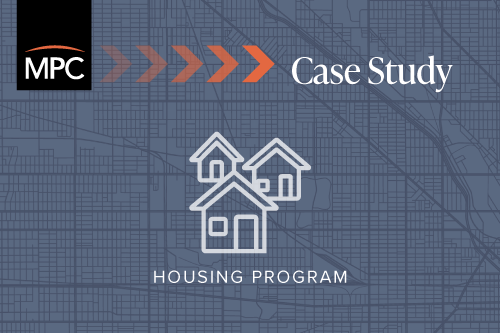Troubled Buildings Initiative
Chicago, Cook County
Housing Program
The Troubled Buildings Initiative (TBI) works proactively to stem the deterioration and loss of viable housing through targeted enforcement efforts and direct intervention with building owners.

Program background
Troubled buildings, whether vacant or occupied, damage neighborhoods, depress property values and harbor crime. Irresponsible management puts tenants’ health and safety at risk and, left unchecked, may trigger a cycle of neighborhood disinvestment and deterioration. Yet these same buildings, if turned around, can have a revitalizing effect on the surrounding community.
In 2003, the City of Chicago departments of Housing, Buildings, Law, Administrative Hearings, Police, Water, Planning, Streets and Sanitation and Human Services, along with a nonprofit partner, Community Investment Corporation (CIC), developed the Troubled Buildings Initiative (TBI). TBI works proactively to stem the deterioration and loss of viable housing through targeted enforcement efforts and direct intervention with building owners. TBI effectively mobilizes the resources and expertise of eight city departments and CIC to ensure that structures are safe and habitable, and help owners obtain financing to rehabilitate problem buildings.
How it works
TBI coordinates the response of city agencies to address conditions in select buildings that pose a threat to the community. The process begins when a building is referred to the program by a city department, alderman, community development organization or concerned citizens.
Once the City receives the referral, the Dept. of Buildings inspects the property, and if applicable, writes up code violations. If the City finds violations, the case is referred to the Dept. of Law for prosecution.
TBI monitors buildings in the program before, during and after prosecution. Before any action is taken, TBI works with the owner to improve the building and bring it up to code. When owners fail to bring their properties into compliance, the city uses a variety of strategies to create a change in ownership, including court-appointed receivers, transferring city liens to CIC for foreclosure, negotiating with lenders for the sale of delinquent notes for foreclosure and purchasing the building for back taxes. In the event TBI is successful in removing a poor manager, City and CIC staffs continue to monitor the new building owners to ensure they address code violations. In cases where the building is foreclosed and CIC is the successful bidder, CIC’s goal is to redevelop the property and create affordable housing in the building—in most cases rental, but also some for sale.
Building on the success of these efforts, in 2006, the City expanded the program to include vacant buildings. The goal for the expanded initiative is to reduce the number of deteriorated, unsafe and underutilized vacant and open buildings in Chicago by at least 75 percent in one year. This will be achieved by a collaborative effort involving the Police, Buildings, Law and Housing departments to:
- Secure the buildings according to municipal code, making them inaccessible to the public and off-limits to criminal activity; and
- Rehabilitate, demolish, forfeit or sell at least half of the buildings.
Contact
Department of Planning and Development, City of Chicago
312-744-4190, www.cityofchicago.org
-
Goal
Increase tenant comfort and safety and decrease neighborhood blight by saving properties that are falling into disrepair.
-
Target
Property managers and owners
-
Financing
Each fiscal year, the City of Chicago and the nonprofit Community Investment Corporation (CIC) allocate $1 million in Community Block Grant funds and $1 million in corporate funds to the program.
-
Success
As of 2014, TBI had evaluated conditions in more than 700 buildings, and overseen the rehabilitation of 345 buildings with nearly 7,000 units.
-
Lessons learned
The initiative requires significant investments of time and resources to handle ongoing tracking of properties, interdepartmental coordination and strategic interventions.